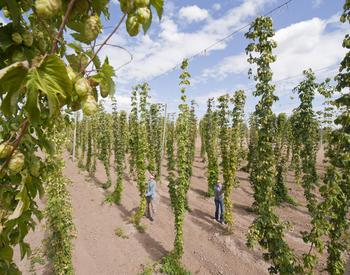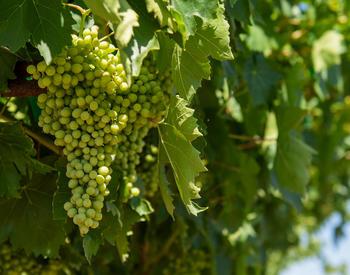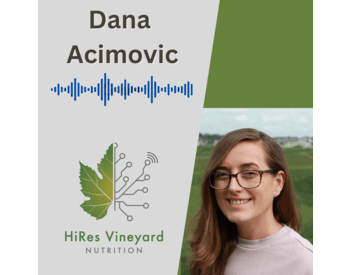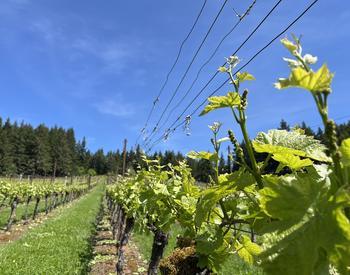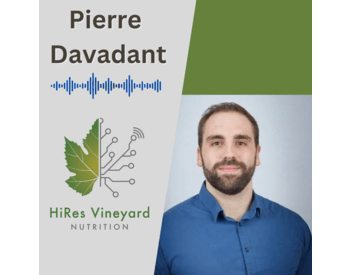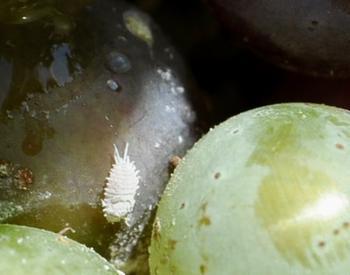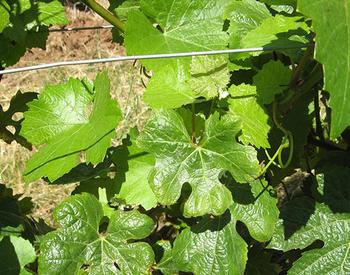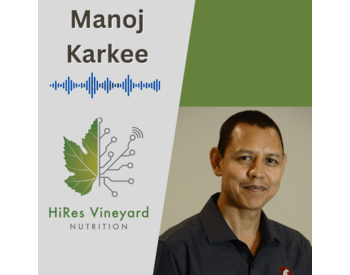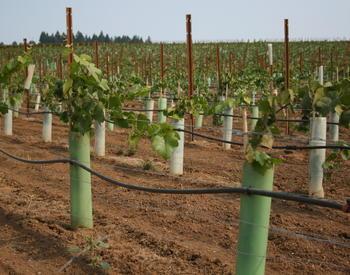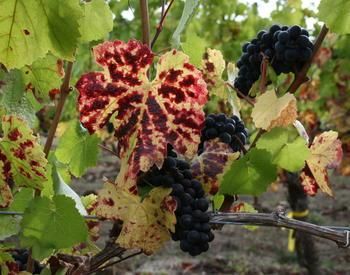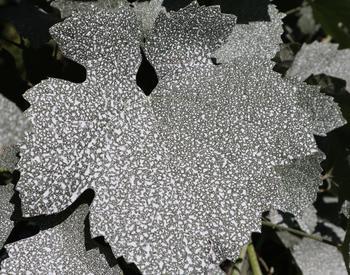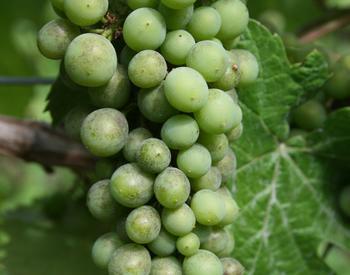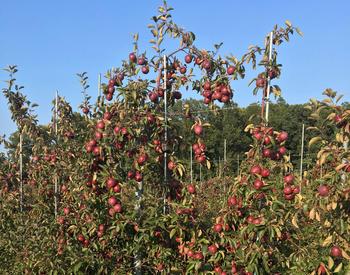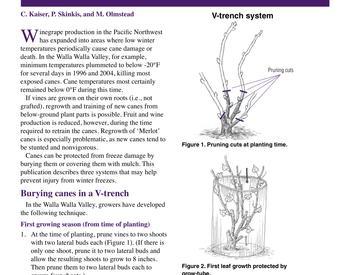Transcript
00:00:00 Patty Skinkis
This is the High-Res Vineyard Nutrition Podcast Series, devoted to helping the grape and wine industry understand more about how to monitor and manage vineyard health through grapevine nutrition research. I am your host, Dr. Patty Skinkis, Professor and Viticulture Extension Specialist at Oregon State University.
00:00:22 Patty Skinkis
Today we're going to be talking about nitrogen, now I've had a number of guests on this podcast who've spoken about nitrogen and its importance in the vineyard, and I'll be shifting the focus today towards the wine impacts. But before I start, I have to give a little summary of what we know about nitrogen just to preface this conversation. We know that managing vineyard nitrogen in wine grape vineyards comes down to two factors, at least from the viticulture perspective. First, management of vine health and vine growth and yield. The second is fruit nitrogen, nitrogen in the fruit is important for a healthy wine fermentation and there are analyses that we can do on the must to determine if we have enough nitrogen, known as Yeast Assimilable Nitrogen, or YAN, and those numbers are important for the winemaking process. This information allows winemakers to decide whether to supplement or not or to use a certain yeast strain. There are varying winemaker opinions, at least from what I've heard from winemakers here in Oregon, about how to adjust the YAN if they need to or how to deal with a low YAN fermentation. Some prefer to be minimalist and not add any nitrogen, preferring it coming from the fruit itself or from the vineyard, and others are comfortable adding supplements regularly and the argument has come down to wine quality, at least from winemakers here in Oregon. And there's some that will say that there is an evident wine quality difference between if you're adding nitrogen in the vineyard or the fruit's coming in with nitrogen, versus if you're adding it into the fermentation, So, we are unsure whether we can simply replace nitrogen in the winery or do a special winemaking tactic to do so, but to test this, researchers within the High Res Vineyard Nutrition Project are addressing this question. With us today is Megan Mershon, a graduate research assistant and master's candidate in the lab of Dr. Amanda Stewart at Virginia Tech, and she's going to speak to us about some of her research that addresses this question of whether nitrogen management in the field or the winery has an appreciable impact on the sensory characteristics of wine, but also how it's changing wine chemistry.
Thank you for joining us today, Megan.
00:02:42 Megan Mershon
Thanks Patty. It's good to be here.
00:02:44 Patty Skinkis
I'm really excited to hear about some of your research because we've been mostly vineyard centric on this podcast, and I know that a lot of our listeners are likely more on the vineyard side and I've always found the vineyard managers, viticulturists to be very interested in the wine side of things too. Because ultimately it impacts what they do in the vineyard. Of course, I hope that there's winemakers listening as well and so I'm hopeful that we have a good conversation that's going to pique the interest of both parties. Before we get started, can you tell me a little bit about yourself and how you got started on Wine Sensory research?
00:03:23 Megan Mershon
Absolutely, I am a food scientist by degree and trade. I have an undergraduate degree in food science from Penn State University, love it up there. After, I graduated, I decided to work in the industry and found a job working for a chocolate company, which is a wonderful product to work on if you ever get the chance but its sweet, it's delicious and I got to do a lot of sensory work in tasting that product. At some point, I decided that I wanted to do more research and less development. I decided to come back to school and what pairs better with chocolate than wine. So, I like wine and I wanted to study something that I enjoyed, so I decided to find some wine research and Dr. Stewart had this amazing opening working on this big project and it's been exciting to learn a lot about the viticulture side of things, and how that impacts the winemaking process.
00:04:10 Patty Skinkis
So can you tell us a little bit about how the project is structured that you're working on and what your role is in the project.
04:16.35 Megan Mershon
I know a lot of this project is working on viticulture, and we're taking that one step farther. We are working with a viticulturist up in one of our agricultural research and extension centers in Northern Virginia. Dana Acimovic, she’s awesome, has been doing all our grape growing and coordinating. Her research is looking at how vineyard nitrogen treatments impact vine growth and berry quality. So, we're looking at three different soil treatments of nitrogen application and two different foliar treatments of nitrogen application. So, she's looking at how those treatments impact the vines and the grapes, and we're taking that one step further to see how that vineyard nitrogen application impacts the wine quality and the wine chemistry and sensory aspects. So, we're taking a viticulture project and just moving it forward and seeing how the wine itself is changing based on those treatments.
00:05:10 Patty Skinkis
It is the grapevine to wine continuum that we unfortunately don't see as much as we would like in all of the research that's published out there. So, this is going to be fantastic! I know the work is being done in Chardonel. Can you speak a little bit about Chardonel for the listeners who aren't familiar with that grape variety?
00:05:30 Megan Mershon
Chardonel is a cold hardy hybrid grape with parents being Chardonnay and another hybrid. I don't want to get it wrong, but it was developed by Cornell in their grape breeding program, and it does relatively well in Virginia. It definitely has a higher juice yield (than Chardonnay), which is good for growers who are having trouble getting volume or quantity of grapes grown in Virginia which is a little bit harder with Vitis vinifera varieties. So, we're looking at these hybrids that are able to last through the winter and provide good yield and good quality grapes. It's very similar to Chardonnay, as you can probably tell from the name. Chardonel and Chardonnay, very similar white grapes and it's been really fun to look at and see that hybrid grapes can produce high quality, good wine from the East Coast, and understand how those hybrids are impacting farmers and vineyard managers and growers.
00:06:22 Patty Skinkis
That's great! Can you tell us a little bit about the main question of the research that you're conducting with respect to nitrogen?
00:06:39 Megan Mershon
We want to know if vineyard managers who are applying variable rates of nitrogen across their fields are going to see differences in berry quality, based on those applications, and will that cause a problem in their final wine product. We want to see if there are differences in the wine that's created from these different nitrogen fertilizing techniques (or ratios or quantities), and we want to see if there are differences, what are they and can we quantify them or describe them from a sensory or a chemical perspective? So, we're looking at the wine from these nitrogen treated grapes to see if there are chemical differences or sensory differences.
00:07:13 Patty Skinkis
Are you targeting any specific compounds to begin with?
00:07:17 Megan Mershon
Not specifically. Our lab--Dr. Stewart's Lab--focuses a lot on YAN, which is yeast aimable nitrogen. This is nitrogen that yeast can use during fermentation, and amino acid profile. So, we're going to be focusing on amino acids and their role in fermentation. But, we are going to be doing a comprehensive look at ethanol content, residual sugars, sulfites, volatile acidity, titratable acidity, pH, you know, the wide range of testing that winemakers or grape growers will do in their vineyard, because we want to make sure our research is applicable to the people who are doing this in the industry.
00:07:51 Patty Skinkis
So, it's more than just YAN. I like that, and that's a lot of work and it’s a lot of compounds, especially when trying to analyze sensory plus the exploratory components of the different compounds. So, you're actually making the wines. Can you tell us a little bit about your wine making procedures and some of the analysis procedures that you're using?
00:08:20 Megan Mershon
Yeah, absolutely. Our winemaking procedure is very simple and straightforward. We want to make sure that we can preserve the nitrogen effect throughout the winemaking process. The nitrogen effect in the vineyard... So, when we made our wine, we took our grapes, we pressed them, and we used just a stainless-steel basket press, very simple. We took our juice from each of the 6 treatments that we have in the field and then separated each treatment into 2 juice slots, so we were able to ferment with 2 different yeast strains. We wanted to see if different yeasts were using the nitrogen levels or the amino acid contents differently, and how that would impact the wine. We also wanted to see if our treatments were going to impact how fermentation occurred in both of those yeasts. So, we ended up with a total of 12 different wines which we fermented. We fermented them to dry just under what we defined as less than one percent residual sugar. We bottled them with a little bit of a nitrogen cap so we could keep them in the fridge for our sensory. We didn't do anything fancy, no malolactic, no oak aging, no bottle aging. Nothing crazy. We were just trying to keep it very simple and straightforward. We did add sulfites so that we could make sure we could preserve our wine… preserve the qualities in it, without getting people coming into sensory and looking at our wine and thinking that it was brown or not desirable, or didn't want to taste it or anything like that. So again, our process was very simple and from there we're going to be looking at chemical analysis which is going to include all those things I mentioned previously… TA, VA, pH, sugars, and then all of our nitrogen analysis so all of our YAN analysis… and then amino acids as well, along with ethanol and final sulfite content. Then from that point, we're going to be doing sensory analysis which I actually just completed in February. And what we did is we had panelists from our surrounding Virginia tech area come in and taste our wines. We had 12 wines for them to taste and we asked them to come in and they were given 12 wines in black glasses so they couldn't see anything, and we wanted them to make sure that they were only picking up flavor and aroma differences, because color is going to vary. So, we had them come in, they were able to swirl, sniff, taste the wines, everybody had to spit out their wines because we can't have people stumbling out of our labs. Once they tasted them they were asked to group them based on perceived similarity. Green apple notes or smelled like flowers for example, things like that. We'd ask them to group them together, and then for every group, they were asked to give it a little description. Some of them tasted more like Cotton candy, and others tasted more like alcohol because sometimes that’s just how people know to describe it as. We just wanted to make sure they liked to drink wine, that was our only requirement. These were not experts coming in, we had people say the wines were good and the wines were bad and we also had people who drink a lot of wine who came in and said, I don’t know, that they found buttery notes from a Chardonnay, which is great, and if they are perceiving that, that’s fantastic. We just want to understand how they were perceiving these wines, and from there we were able to group the wines and understand how they're related, based on how they were grouped by our panelists.
00:11:31 Patty Skinkis
You did sensory first and then you're going to do the analytics.
00:11:36 Megan Mershon
Yeah! And that's just how the timing worked out. We needed to make sure we had enough people on campus, and as most colleges, my understanding is that we get a lot of students leaving campus and people leaving in the summer, so we wanted to make sure we had time to get enough panelists to come in and taste all of our wines prior to the summer break and Blacksburg becoming a ghost town.
00:11:55 Patty Skinkis
I think that's also a good strategy though. In other studies I've done, I've often skipped all of the chemical analysis to go straight to sensory, and see if we could target something that was different in the sensory that we could explore, so we're not looking at absolutely everything. I think that works in your favor probably. What vintages were these consumers tasting, what was the timeline from the time of harvest, to bottling, to tasting?
00:12:28 Megan Mershon
This was the 2022 harvest, in September 8th and 9th I believe here. Then, grapes came back to campus with me on a Saturday, and I pressed on the following Monday because I didn’t want to work on a Sunday. We got them fermenting within a week since we were waiting on some yeast to come in. That's part of the reason why we're using our sulfites to make sure we had juice that was still stable enough to be fermented at the end of the week.
They fermented for about a month. We were a little on the long side due to a small batch variation. We noticed while we were doing our winemaking that some of our yeast was settling at the bottom of our very small 1.5 gallon carboys. That, we think, was causing some yeast die off at the beginning of our fermentation, so they weren’t allowed to really utilize the sugar in the juice. So, we had to make a couple of corrections and then we got them bottled after about a month. That was probably sometime in October, and then they were in bottle until February, when I ran them. They were in bottle about four months, which I think it gave them a little bit time to mellow out. We definitely tasted all the wines when we finished making them, and everybody I was bottling thought that the wines were a little aggressive, including me. By the time we tasted them in February they were more like wine, and that's what we were going for. We were going for something that was representative of the wine category.
00:14:13 Patty Skinkis
Especially using consumer panels, you'd want to introduce something that's more like what they would be drinking rather than and early product, which is something that may be more suited for researchers to use, taste and evaluate… or even winemakers who are doing their own evaluations. So, just out of curiosity with Chardonel, what is the timeline for a producer who's making Chardonel? Is it similar to Chardonnay, like from a harvest to bottling and to sales? What is the timeline on that?
00:14:33 Megan Mershon
I'm going to be honest with you, I'm not entirely sure, but I'm thinking that I've seen some Chardonel in the area that are stray variety wines. They can be oaked and aged like Chardonnay, even I don't think it's common, but I also know that it's used because it has a nice yield. It's also used for blends in white wines as well. So, if you're just going to be doing a blend I would probably think that you will probably be seeing the 2022 vintage come out relatively soon, as this recording in May we'll probably see them come out sometime this summer, which will be exciting. Hopefully I'll be able to taste some of the Chardonel that I got to work on this year from the actual winery that we were working with.
00:15:12 Patty Skinkis
I know it's brand new research, but what were the major findings that you have found so far? Maybe from the first panels that you've done.
00:15:37 Megan Mershon
We're looking right now to see if we can find any patterns within our groupings. So, we do this method of analysis that involves coding and fancy math, that I don't entirely understand, but we are able to see there are patterns between our wines, based on our consumer's grouping. If, let's say wine 1 and wine 2 are grouped together most often, we'll be able to translate that mathematically and say okay, they are related. We'll be able to graph those relationships between wines and so when we look at the graph of the wines, we can say we can look at them based on soil treatment, foliar treatment in the vineyard and also on our yeast strain treatment. In the winery we haven't seen too many patterns, I would say for the most part our moderate levels of soil treatment are the most closely grouped together. But again, there's not a ton to support that right now, and what I'd really like to see is the YAN content to combine with this sensory data in order to understand maybe if we're not seeing patterns based on flavor, then maybe we are able to see patterns based on chemistry. We could be seeing sensory data that is similar to each other, or not really showing a lot of differences, which is really good news for vineyard managers who say okay, you know, treat this however you like and you shouldn't see problems coming into the winery. But, I do want to see if there are chemical instances that are impacting those sensory patterns, particularly if there are any based on the chemistry data. So, maybe not based on the sensory data we're seeing patterns, but if we take those sensory groupings and we add that layer of chemistry data on top, maybe we'll start to understand why we're not seeing groupings.
00:17:18 Patty Skinkis
So, you are basically saying that maybe it's because there is not as much difference in one area versus another, which leads me to the question, when you receive the fruit before making the wines, did you do any adjustments because there were variations, or was it because the chemistry was balanced between the different field treatments?
00:17:38 Megan Mershon
The only analysis we did prior to our wine making was our pH, just to make sure that we were within a reasonable range for our yeast to be able to get fermentation, and it wasn't going to be so acidic that they were just going to die off. Other than that, we haven't really looked at the analysis. We wanted also to make sure we were within range of our YAN contents. I believe everything was within reasonable range of values, somewhere over a hundred milligrams per liter, which could be very low end for some producers and very high end for other producers. But we wanted to make sure we were going to get fermentation; however, we haven't really done too much analysis yet to understand what our juice looked like and that's part of my work. This summer I’m going to be looking at juice from some of Donna's, as well as some of our viticulture berries at a different time points after veraison and at harvest, to see how YAN changes in the vines based on our different treatments and also from pre-fermentation juice to wine.
00:18: 48 Patty Skinkis
So more to come it’s always with more research, and that's good. So, you mentioned you've got the 2022 harvest and that's in process now, but how many more seasons or vintages do you plan to do for this project?
00:19: 03 Megan Mershon
For the viticulture side of it we have another year. We have 2 years currently for Chardonel data and we have 1 more year coming up this fall for the 2023 vintage. Then, in terms of wine making, where we just starting conversations about how we want to treat this year's harvest. We're going to be doing another round of winemaking. We'll probably be looking at a different pattern. We're going to try and look at some winery adaptations, kind of like you were saying earlier. We're going to be trying to look at how winery additions versus vineyard additions impact wine quality. We haven't sorted out all the details of that yet, but that's I think where we're going with this and that's what we'd like to see for the 2023 vintage. A lot of times with food science research we can get away with doing 1 year one treatment and see how it goes so, we're going to try and do something different to see if we can add a little bit more from our Virginia side to this to this grant.
00:19: 57 Patty Skinkis
That's great because I think it's easier to start with “let's see what our baseline is” before adjusting in the winery. That's great and that's building upon some of the other work that has been published. Unfortunately, not a lot of it to compare the vineyard versus the winery applications in the vine and wine. And, are there any other wines that you're planning to do beyond just the Chardonel? Is there any other field trials which wines are going to be produced?
00:20:26 Megan Mershon
Right now, on our Virginia side, we're doing Chardonel as our big trial that we've had for 3 years, we're working with other commercial wineries and vineyards to get our grapes and do our treatments. That’s always a little bit of a challenge but we do have another Chardonnay plot that we've been able to work with, since the vineyard manager is willing to help us out and get us a plot as well. So, we'll see how much fruit we can get because we don't want to be taking vineyard fruit, but we want to do what we can with what we have. So, we'll see what it comes down to in August or September. We've had a lot of frost up here, a couple of frozen mornings, so it's been a little bit of a challenge for vineyard managers and… we're just going to see if it'll either be Chardonnay or Chardonel next year. I'd like to see Chardonel just because I think it'd be good to understand. We have our baseline with Chardonel and then it would be cool to add on top of that, and be able to compare. I guess not apples to apples, but grapes to grapes.
00:21:43 Patty Skinkis
That's great. I think the interesting thing about Chardonnay is that it is one of the grapes that we decided, as a research team of the HiRes Vineyard Nutrition Project team, to replicate across different regions, Oregon, Washington, New York and Virginia, so it's good to see what we can come up from these different regions. What do you think are the broader applications of this work? What do you hope that will come out of the project, if everything goes well?
00:22:21 Megan Mershon
I hope that the work we do is applicable and easy to understand for vineyard managers and winemakers. I want to make their lives easier and if we can advise to growers to spray the whole field or one row with nitrogen and call it a day,. That they shouldn't have to worry about anything going wrong in the winery, it would be great. I want to make sure that whatever we're doing is easy for industry to understand and apply to their own work. So, if we can tell them to not worry about it that'd be great. I think it’s always a good goal to have 1 less thing to worry about on your plate, and if we can do advise a nitrogen management in Virginia, saying “hey this is something that you don't have to worry about at least in Chardonel” without any concern it would be awesome to me.
00:23:10 Patty Skinkis
Do you have an understanding on how much nitrogen is a problem in musts in Virginia or specifically with Chardonel?
00:23:17 Megan Mershon
Not as much as potassium is. Nitrogen is commonly used as a fertilizer and there's not much more to it than that. I think it's just not well understood in Virginia as most wine and viticulture is. A lot of the research comes out of the west coast and Europe, and I think any research that we can get done on the East Coast will benefit viticulture, vineyard managers and winemakers. We are a new industry, so we are making it happen and trying to help out everybody in any the way we can.
00:23:47 Patty Skinkis
Absolutely because it is so true that although things can be done in these other wine-growing regions, there is this regional specificity in soil type, climate, different challenges that gets really tough to just say, “well this is what worked over here and let's translate it over there”. I know Tony Wolf did a number of nutritional type studies over the years that basically led into what Donna is working on today, and hopefully just building upon that prior regional knowledge that he developed years ago. For me it's great to see two things: this regional work happening, and an interspecific variety being included, because I'm seeing more and more that people are becoming interested in what's going on even in traditional Vitis vinifera growing regions. They're interested in seeing what's out there on some of these interspecific varieties. And so, I think there's going to be takeaways from this project even from wine quality standpoint, because wine quality research is important in those new varieties even though Chardonel is not all that new, since it has been around for a while. But, there's always more work that can be done, which is fantastic.
So, I want to wrap up with a fun question. You're working on a whole bunch of different sensory components of the wine and… if you could tackle any question in Sensory science, what would it be?
00:25:26 Megan Mershon
I think about this every time I eat a new food product. I always go to the grocery store, I pick something up and I'm like, “I wonder how they did this?” But recently I was talking to somebody about biodynamic wines and I think they're misunderstood wines along with the organic sector. There's a lot of crossover between those 2 and a lot of “unknowns” in the world of wine when it comes down to that. It's organic or biodynamic, what do those terms mean in terms of sensory quality? What does that tell a consumer? When you go to the bottle shop or the wine store, or wherever you go to get your wine, what do all those terms on the bottle mean? So, I think I would like to look at consumer marketing and how it's perceived by consumers. What do those words mean to consumers and then are there actual differences in wines that are being marketed that way? Are there flavor differences? And with every sensory project I think you should have a little bit of chemistry data to go along with it to back it up. So, what are those sensory and chemical differences between those wines? If we're going to be doing a biodynamic vineyard, what makes that different from an organic vineyard or from a natural managed one? When producing wine those are questions that I think can help consumers get wine into their hands that they enjoy more. Wine has always had a little bit of a pretentious tag on it, but I think wine can be for everybody! So, I think the more we can help people understand what wine is and what it tastes like, the better for the industry. I think some of the sensory terminology and consumer market terminology could really be beneficial for understanding the differences you can detect.
00:27:12 Patty Skinkis
That's a really challenging concept but it is intriguing. I like the fact that you mention what is the actual differences that you can detect -if any- that link to the farming practice, because there is this big push for healthier vineyard practices. Whether it's biodynamic or organic or regenerative agriculture, a lot of times we just assume it's just related to the farm health rather than necessarily taking it all the way through to the wine quality, so that is a great question.
So, the second question I wanted to ask you is, what is the most interesting food product that you have ever worked on or would like to work on?
00:27:59 Megan Mershon
The most interesting food project I've ever worked on would have to be pet food. I worked in a pet division for a company one summer for an internship, and people love their pets and I'm very happy for them, but I don't think I ever need to do that again. That was probably the most interesting, but going forward, things I would want to work on more, I would have to say space food. I’ve always been fascinated by space food, like how they get nutrients and high-quality food to Nasa. How to grow peppers in space, and like… how is that possible? How are they doing that?, and I think that would be a really fun thing to think about and work on, because it's a little bit different than growing food on the ground, with gravity and actual nutrients in the air and different compounds.
00:29:00 Patty Skinkis
You've intrigued me. You've opened the door with a pet food. So, was the pet food analysis done with human sensory work or was it done by animals? Or was it just compositional work (analysis of composition)?
00:29:17 Megan Mershon
I did compositional work. However, we did have a team a sensory team sensory pet team that did tastings. We did have dogs and cats do tastings, there are panels. They bring them in and they put 2 bowls of food in front and whichever one they go towards, that wins the sensory test. It's very simple. I do remember someone asking me to come and do a dog treat tasting while I was there and I kind of was questioning it but it was another intern and I was like you know what, I'm going to support them, interns support each other, so I went and I did a dog treat tasting and it was wild. It's all food grade all you know human grade food that you can eat. You know you can always eat your dog's food, your cat’s food. Um… So that's a definitely an experience that I don't think I'll ever forget. But you know you eat pepperoni 16 times a day and you think “I don't need to do this anymore. I'm, I think I'm all good.”
00:30:17 Patty Skinkis
Well, we're glad that you decided to shift towards working on wines and specifically working on wine… on a question that is very practical and that gets back to the vineyard and to the winery, on how to manage nitrogen, and whether it makes a difference on the end quality especially for wine growers. That's what they're most interested in. So, thank you for joining us today and for sharing the information about your research. To learn more about Megan's work, she's going to be presenting at the American society for enology and viticulture Eastern section meeting this June of 2023 and likely you could find a summary report from that event if you're listening to the podcast after that event happens.
But, to learn more about this project and others within the High Res Vineyard Nutrition project. You can check out our website at https://highresvineyardnutrition.com/ and check out our social media -- we're on Linkedin, Instagram and Twitter (X).
We know nitrogen is important for a healthy fermentation, but does the source of nitrogen matter? Should it be added in the vineyard or the winery? In this episode, Megan Mershon, graduate research assistant at Virginia Tech, describes research they are conducting to compare wine sensory response from nitrogen trials they’ve conducted in the HiRes Vineyard Nutrition Project.
